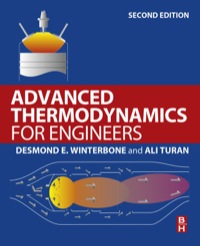A mass of (0.008 mathrm{~kg}) of helium is contained in a piston-cylinder unit at (4 mathrm{bar}) and
Question:
A mass of \(0.008 \mathrm{~kg}\) of helium is contained in a piston-cylinder unit at \(4 \mathrm{bar}\) and \(235^{\circ} \mathrm{C}\). The piston is pushed in by a force, \(F\), until the cylinder volume is halved, and a cooling coil is used to maintain the pressure constant. If the dead-state conditions are 1.013 bar and \(22{ }^{\circ} \mathrm{C}\), determine:
(i) The work done on the gas by the force, \(F\);
(ii) The change in availability;
(iii) The heat transfer from the gas and
(iv) The irreversibility.
Show the heat transfer process defined in part (iii) and the unavailable energy on a \(T-s\) diagram, and the work terms on a \(p-V\) diagram.
The following data may be used for helium, which can be assumed to behave as a perfect gas:
Ratio of specific heats, \(\kappa=c_{p} / c_{v}=1.667\)
Molecular weight, \(m_{w}=4\)
Universal gas constant, \(\Re=8.3143 \mathrm{~kJ} / \mathrm{kmol} \mathrm{K}\).
[-3.154 kJ; \(1.0967 \mathrm{~kJ} ;-10.556 \mathrm{~kJ} ; 2.0573 \mathrm{~kJ}]\)
Step by Step Answer:

Advanced Thermodynamics For Engineers
ISBN: 9780080999838
2nd Edition
Authors: D. E. Winterbone, Ali Turan





